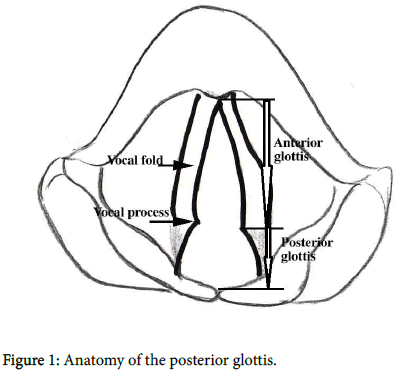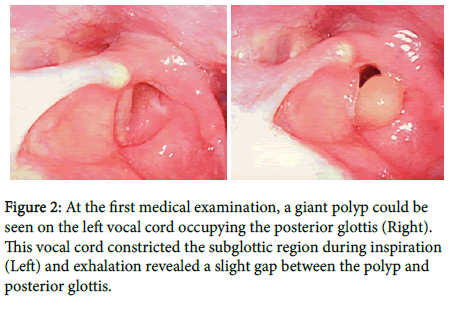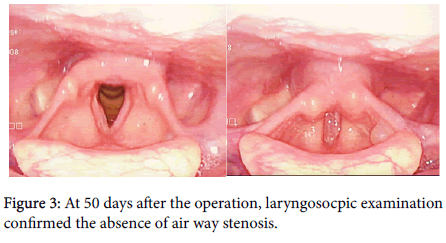Case Report, J Otol Rhinol Vol: 7 Issue: 6
A Large Vocal Fold Polyp Causing Dyspnea
Takeshi Kusunoki1*, Hirotomo Homma1, Yoshinobu Kidokoro1, Aya Yanai1, Satoshi Hara1, Ayuko Oba1, Ryo Wada2 and Katsuhisa Ikeda3
1Department of Otorhinolaryngology, Juntendo University of Medicine, Shizuoka Hospital, Shizuoka, Japan
2Departement of Pathology, Juntendo University of Medicine, Shizuoka Hospital, Shizuoka, Japan
3Department of Otorhinolaryngology, Faculty of Medicine, Juntendo University of Medicine, Shizuoka, Japan
*Corresponding Author : Takeshi Kusunoki
Department of Otorhinolaryngology, Juntendo University of Medicine, Shizuoka Hospital, 1129 Nagaoka Izunokuni-shi, Shizuoka 410-2295, Japan
Fax: +81-55-948-5088
E-mail: ttkusunoki001@aol.com
Received: August 16, 2018 Accepted: September 19, 2018 Published: September 26, 2018
Citation: Kusunoki T, Homma H, Kidokoro Y, Yanai A, Hara S, et al. (2018) A Large Vocal Fold Polyp Causing Dyspnea. J Otol Rhinol 7:6. doi: 10.4172/2324-8785.1000355
Abstract
Laryngeal polyps are common, but some hospitals have reported that a giant vocal fold polyp could cause dyspnea. We encountered a giant vocal fold polyp with dyspnea. Under general anesthesia, laryngomicrosurgery successfully improved the symptoms of the dyspnea. In this case, stenosis of the posterior glottis (considered to be the respiratory glottis) due to a giant vocal fold polyp was thought to be the cause of the preoperative dyspnea.
Keywords: Large fold polyp; Posterior glottis; Dyspnea
Introduction
A 68- year-old Japanese woman consulted our hospital with a twoweek history of dyspnea. Her personal history showed that she was a heavy smoker (10 cigarettes daily for 48 years). A giant polyp on the left vocal fold was observed in the first medical examination.
A vocal process could divide the glottis into two parts (the anterior and posterior glottis) (Figure 1) [1]. This vocal fold polyp occupied the posterior glottis. It had a wide pedicle and could be flipped into and out of the glottis (Figure 2).
Case Presentation
At preoperation, our otorhinopharyngolarygologists consulted expert anesthetists concerning treatment planning including anesthetic methods. As a result, the patient was brought to the operating room, where microlaryngoscopy and excision of the vocal fold polyp was accomplished under general anesthesia without any complications. The patient has experienced no symptoms of dyspnea after operation (Figure 3). The histopathological findings indicated a vocal fold polyp.
Discussion
Laryngeal polyps are one of the most common lesions of the vocal folds. Acute airway obstruction from laryngeal polyps is rare. Polyps may reach a large size and cause dyspnea [2,3].A Cause of vocal fold polyp has been known to be smoking [4]. Umeno [5] reported that most patients who underwent emergency surgery due to large vocal folds were middle-high aged women with smoking. Our patient was 68-year-old Japanese woman and a heavy smoker (10 cigarettes daily for 48 years).
Hirano [1] reported that, during vocal fold adduction, the larynx closes posteriorly at the supraglottis but not at the glottis, causing a conic space in the posterior glottis. The area of the posterior glottis accounts for more than half the entire glottal area. On the histological findings, the mucosa of the posterior glottis is lined with a pseudostratified ciliated epithelium, which is respiratory epithelium. The posterior glottis can be regarded as a respiratory glottis. Even if there is a severe polypoid vocal fold, opening the posterior glottis can avoid dyspnea. Therefore, in this case, stenosis of the posterior glottis (considered to be the respiratory glottis) due to a giant vocal fold polyp was thought to be the cause of the preoperative dyspnea. Yanagisawa [6] described that sudden dyspnea due to a large vocal fold polyp could cause cardiorespiratory and sudden death.
Our case could perform endotracheal intubation under general anesthesia without complications and keep airway. Laryngomicrosurgery successfully removed vocal fold polyps and improve dyspnea. Some hospitals [2,5,7,8] recommended early tracheotomy for cases of large laryngeal polyps that were difficult to intubate, and perform laryngomicorsurgery at second stage. Because endotracheal intubation have the possibility to lead to dislodge polyps into the trachea and bleeding of polyps. Asajima et al. [9] presented anesthetic management for the resection of a giant laryngeal polyp as follows.They intubated the patient with a longtube (ID 3.0 mm, length 25 cm) and used high frequency jet ventilation (HFJV). As the poly remained in the larynx by positive pressure in the trachea, surgical resection was performed without difficulty.
Conclusion
Cases of vocal fold polyps occupied the posterior glottis (considered as respiratory glottis) cause dyspnea with the upper-airway obstruction. Therefore, this case should need for an emergency operation. At preoperation, surgeon and anesthetist should discuss about treatment planning including anesthesia methods.
References
- Hirano M, Yoshida T, Kurita S, Kiyokawa K, Sato K, et al. (1986) Functional anatomy of the posterior glottis. Pract Otol (Kyoto) 79: 343-350.
- Shergill GS, Shergill AK (2015) Large vocal cord polyp: An unusual cause of dyspnea. BMJ Case Rep.
- Ochiai A (2016) Large laryngeal polyp causing airway obstruction. Oxford Med Case Rep 8: 219-220.
- Yonekawa H (1988) A clinical study of Reinke`s edema. Auris Nasus Larynx 15: 57-78.
- Umeno Kadota H, Yurita S, Adachi K, Inguchi T, Fukushima J, et al. (2010) Case Study on Vocal fold polyps. Otologia Fukoka 56: 19-23.
- Yanagisawa E, Hausfeld JN, Pensak ML (1983) Sudden airway obstruction due to pedunculated laryngeal polyps. Ann Otol Rhinol Laryngol 92: 340-343.
- Sellami M, Chaabouni MA (2017) Giant laryngeal polyp: An unusual indication of tracheostomy. Pan Afr Med J 26: 76.
- Pathak RD (2000) Fibromyxomalarynx-emergency management. Indian J Otolaryngol Head Neck Surg 52: 177-178
- Asajima R, Komoda Y, Sai Y, O ku S, Nosaka S (1997) Anesthetic management for the resection of a giant laryngeal polyp: A case report. J Jpn Soc Clin Anes 17: 384-387.
 Spanish
Spanish  Chinese
Chinese  Russian
Russian  German
German  French
French  Japanese
Japanese  Portuguese
Portuguese  Hindi
Hindi 





